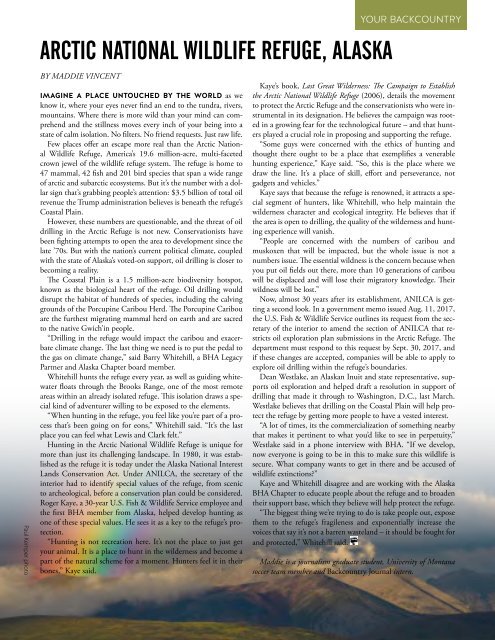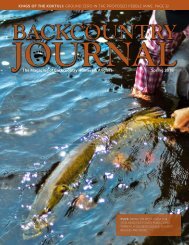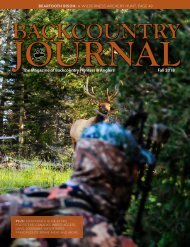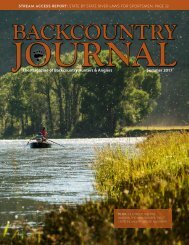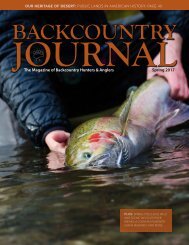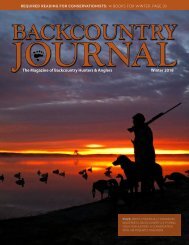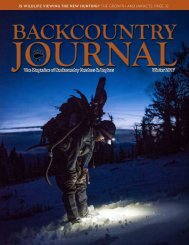BCJ_FALL17 Digital Edition
You also want an ePaper? Increase the reach of your titles
YUMPU automatically turns print PDFs into web optimized ePapers that Google loves.
Paul Kemper photo<br />
ARCTIC NATIONAL WILDLIFE REFUGE, ALASKA<br />
BY MADDIE VINCENT<br />
IMAGINE A PLACE UNTOUCHED BY THE WORLD as we<br />
know it, where your eyes never find an end to the tundra, rivers,<br />
mountains. Where there is more wild than your mind can comprehend<br />
and the stillness moves every inch of your being into a<br />
state of calm isolation. No filters. No friend requests. Just raw life.<br />
Few places offer an escape more real than the Arctic National<br />
Wildlife Refuge, America’s 19.6 million-acre, multi-faceted<br />
crown jewel of the wildlife refuge system. The refuge is home to<br />
47 mammal, 42 fish and 201 bird species that span a wide range<br />
of arctic and subarctic ecosystems. But it’s the number with a dollar<br />
sign that’s grabbing people’s attention: $3.5 billion of total oil<br />
revenue the Trump administration believes is beneath the refuge’s<br />
Coastal Plain.<br />
However, these numbers are questionable, and the threat of oil<br />
drilling in the Arctic Refuge is not new. Conservationists have<br />
been fighting attempts to open the area to development since the<br />
late ’70s. But with the nation’s current political climate, coupled<br />
with the state of Alaska’s voted-on support, oil drilling is closer to<br />
becoming a reality.<br />
The Coastal Plain is a 1.5 million-acre biodiversity hotspot,<br />
known as the biological heart of the refuge. Oil drilling would<br />
disrupt the habitat of hundreds of species, including the calving<br />
grounds of the Porcupine Caribou Herd. The Porcupine Caribou<br />
are the furthest migrating mammal herd on earth and are sacred<br />
to the native Gwich’in people.<br />
“Drilling in the refuge would impact the caribou and exacerbate<br />
climate change. The last thing we need is to put the pedal to<br />
the gas on climate change,” said Barry Whitehill, a BHA Legacy<br />
Partner and Alaska Chapter board member.<br />
Whitehill hunts the refuge every year, as well as guiding whitewater<br />
floats through the Brooks Range, one of the most remote<br />
areas within an already isolated refuge. This isolation draws a special<br />
kind of adventurer willing to be exposed to the elements.<br />
“When hunting in the refuge, you feel like you’re part of a process<br />
that’s been going on for eons,” Whitehill said. “It’s the last<br />
place you can feel what Lewis and Clark felt.”<br />
Hunting in the Arctic National Wildlife Refuge is unique for<br />
more than just its challenging landscape. In 1980, it was established<br />
as the refuge it is today under the Alaska National Interest<br />
Lands Conservation Act. Under ANILCA, the secretary of the<br />
interior had to identify special values of the refuge, from scenic<br />
to archeological, before a conservation plan could be considered.<br />
Roger Kaye, a 30-year U.S. Fish & Wildlife Service employee and<br />
the first BHA member from Alaska, helped develop hunting as<br />
one of these special values. He sees it as a key to the refuge’s protection.<br />
“Hunting is not recreation here. It’s not the place to just get<br />
your animal. It is a place to hunt in the wilderness and become a<br />
part of the natural scheme for a moment. Hunters feel it in their<br />
bones,” Kaye said.<br />
YOUR BACKCOUNTRY<br />
Kaye’s book, Last Great Wilderness: The Campaign to Establish<br />
the Arctic National Wildlife Refuge (2006), details the movement<br />
to protect the Arctic Refuge and the conservationists who were instrumental<br />
in its designation. He believes the campaign was rooted<br />
in a growing fear for the technological future – and that hunters<br />
played a crucial role in proposing and supporting the refuge.<br />
“Some guys were concerned with the ethics of hunting and<br />
thought there ought to be a place that exemplifies a venerable<br />
hunting experience,” Kaye said. “So, this is the place where we<br />
draw the line. It’s a place of skill, effort and perseverance, not<br />
gadgets and vehicles.”<br />
Kaye says that because the refuge is renowned, it attracts a special<br />
segment of hunters, like Whitehill, who help maintain the<br />
wilderness character and ecological integrity. He believes that if<br />
the area is open to drilling, the quality of the wilderness and hunting<br />
experience will vanish.<br />
“People are concerned with the numbers of caribou and<br />
muskoxen that will be impacted, but the whole issue is not a<br />
numbers issue. The essential wildness is the concern because when<br />
you put oil fields out there, more than 10 generations of caribou<br />
will be displaced and will lose their migratory knowledge. Their<br />
wildness will be lost.”<br />
Now, almost 30 years after its establishment, ANILCA is getting<br />
a second look. In a government memo issued Aug. 11, 2017,<br />
the U.S. Fish & Wildlife Service outlines its request from the secretary<br />
of the interior to amend the section of ANILCA that restricts<br />
oil exploration plan submissions in the Arctic Refuge. The<br />
department must respond to this request by Sept. 30, 2017, and<br />
if these changes are accepted, companies will be able to apply to<br />
explore oil drilling within the refuge’s boundaries.<br />
Dean Westlake, an Alaskan Inuit and state representative, supports<br />
oil exploration and helped draft a resolution in support of<br />
drilling that made it through to Washington, D.C., last March.<br />
Westlake believes that drilling on the Coastal Plain will help protect<br />
the refuge by getting more people to have a vested interest.<br />
“A lot of times, its the commercialization of something nearby<br />
that makes it pertinent to what you’d like to see in perpetuity,”<br />
Westlake said in a phone interview with BHA. “If we develop,<br />
now everyone is going to be in this to make sure this wildlife is<br />
secure. What company wants to get in there and be accused of<br />
wildlife extinctions?”<br />
Kaye and Whitehill disagree and are working with the Alaska<br />
BHA Chapter to educate people about the refuge and to broaden<br />
their support base, which they believe will help protect the refuge.<br />
“The biggest thing we’re trying to do is take people out, expose<br />
them to the refuge’s fragileness and exponentially increase the<br />
voices that say it’s not a barren wasteland – it should be fought for<br />
and protected,” Whitehill said.<br />
Maddie is a journalism graduate student, University of Montana<br />
soccer team member and Backcountry Journal intern.<br />
FALL 2017 BACKCOUNTRY JOURNAL | 5


